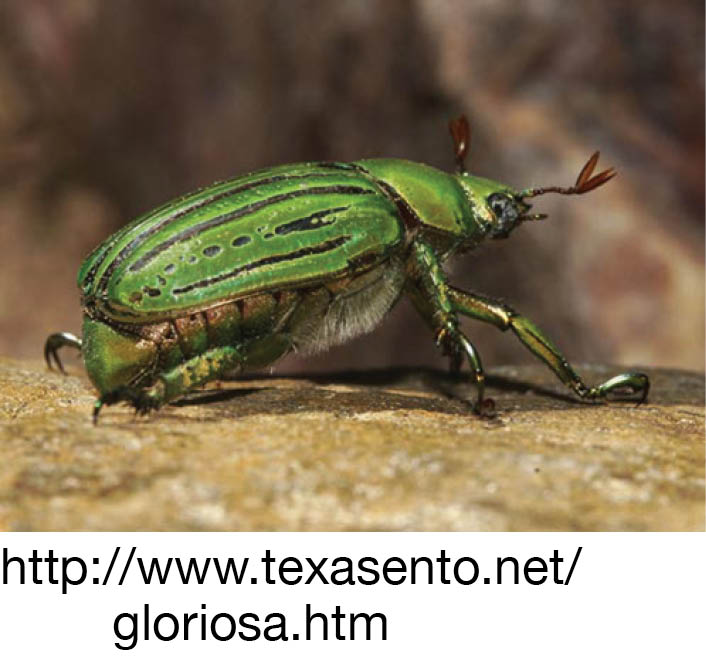

 Most living
things have the colors that we see because of pigments that are in
their skin or shells. The chemicals in these pigments absorb certain
wavelengths of light and reflect other wavelengths. The reflected
wavelengths are what we see and identify as color. Researchers have
discovered that there is another way that color can be produced, and
the jewel (scarab) beetle, Chrysina
gloriosa, gives its incredibly
beautiful color by this method.
Most living
things have the colors that we see because of pigments that are in
their skin or shells. The chemicals in these pigments absorb certain
wavelengths of light and reflect other wavelengths. The reflected
wavelengths are what we see and identify as color. Researchers have
discovered that there is another way that color can be produced, and
the jewel (scarab) beetle, Chrysina
gloriosa, gives its incredibly
beautiful color by this method.
Examining the beetle’s exoskeleton under a
high-powered microscope researchers have discovered the surface is a
“richly decorated mosaic of cusps and color.” The surface has cells
with five, six, and seven sides which gradually twist as layers get
deeper. These cells look like snail shells turned on their sides. These
regions are called focal conic domains, and they twist reflected light
forming a clockwise helix which makes it circularly polarized. Since
different colors have different energies, the amount of twisting will
be proportional to the wavelength, so in the case of the jewel beetle
the highest energy twisted is green, and the beetle is a glorious green
color even though it has no pigment.
The beetle’s green color matches the plants in which
it lives, and allows it to be camouflaged. Dr. Mohan Srinivasarao of
the Georgia Institute of Technology is hopeful that copying this design
system will allow scientists to develop devices that will use circular
polarization as a means of manipulating light for new uses in
technology. The sophistication of God’s design in the natural world is
amazing, and the more we learn of the various methods God has employed
the more sure we can be of His role in the creation.
Reference: Science News,
August 15, 2009, page 12.
Back to Contents
Does God Exist?, SepOct10.



 Most living
things have the colors that we see because of pigments that are in
their skin or shells. The chemicals in these pigments absorb certain
wavelengths of light and reflect other wavelengths. The reflected
wavelengths are what we see and identify as color. Researchers have
discovered that there is another way that color can be produced, and
the jewel (scarab) beetle, Chrysina
gloriosa, gives its incredibly
beautiful color by this method.
Most living
things have the colors that we see because of pigments that are in
their skin or shells. The chemicals in these pigments absorb certain
wavelengths of light and reflect other wavelengths. The reflected
wavelengths are what we see and identify as color. Researchers have
discovered that there is another way that color can be produced, and
the jewel (scarab) beetle, Chrysina
gloriosa, gives its incredibly
beautiful color by this method.